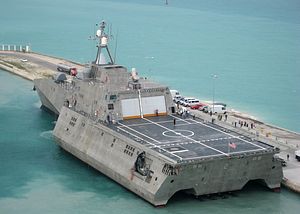Amid escalating tensions between Japan and China, a 12.2 percent budget increase in China’s defense spending, and fears that budget cuts for the U.S. military could have a negative impact on the United States’ ability to “pivot” to Asia, U.S. and Japanese officials have announced plans to co-develop a new high-speed vessel capable of carrying helicopters.
Following a meeting between U.S. Ambassador to Japan Caroline Kennedy and Japanese Foreign Minister Fumio Kishida on March 4, the two governments announced that the Japanese Defense Ministry and the U.S. Department of Defense would hold studies for the joint development of the vessel under the bilateral Mutual Defense Assistance (MDA) agreement.
Although very little information has been released about the project, analysts contend that the trimaran would likely be a lighter variant of the U.S. Navy’s 3,000-tonne littoral combat ship (LCS), a platform designed primarily for missions in shallow coastal waters.
According to reports in Japanese media, the high-speed J-LCS would give the Japan Maritime Self-Defense Force (JMSDF) the ability to quickly intervene during incursions by Chinese vessels near the Senkaku/Diaoyu islets and other contested areas of the East China Sea. Chinese analysts speculate that the J-LCS could be intended as a counter to the PLA Navy’s (PLAN) Type 056 corvettes and Type 022 fast-attack boats, two types of vessels that could be deployed to the region should relations continue to deteriorate. Furthermore, early reports indicate that the slightly enlarged hull of the 1,000-tonne-plus vessels could accommodate SH-60K anti-submarine helicopters and MCH-101 airborne mine countermeasures (AMCM) helicopters.
Coincidentally, the announcement came as the U.S. Navy unveiled a substantial reduction in the number of LCSs it will acquire, from 52 as initially planned to 32. A total of US$1.5 billion was set aside to buy three LCS during FY2015 (down one from a planned four), for a total of 14 through 2019 (twenty LCSs have been funded through FY2014). As a large share of the LCSs in the U.S. Navy was expected to be deployed to the Asia-Pacific, the joint project with Japan could serve as a much-needed supplement to compensate for a trimmed U.S. force deployment, both in terms of reduced production costs and an increased number of surface combatants that, through burden sharing, the U.S. Navy and JMSDF could bring into play during hostilities.
Additionally, the outcome of this project could lead to the development of an alternative version to the current (and expensive) LCS. The U.S. Navy is reportedly seeking such an alternative amid criticism that the platform, sometimes referred to as an “undergunned corvette,” doesn’t pack enough firepower and would be no match against the better-armed — and cheaper — surface combatants (including the PLAN’s 220-tonne Type 022 and 1,800-tonne Type 056) that would see action during combat operations in the Asia-Pacific.

































